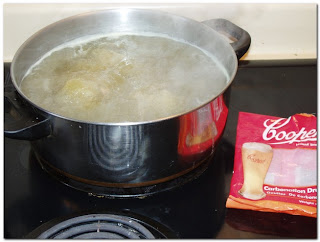 Turns out that she was doing a favor for a friend by forwarding a newspaper (South Bend Tribune) clipping that her friend Anne had asked her to give to me. Apparently, Anne shares an interest in brewing and beer because of the influence of this blog, or more likely because of the bragging my mother does about her children. By the way, for you young'uns not familiar with this cultural imperative, saving and passing on clippings is a popular past time in the Midwest. As important as jello with fruit cocktail and mini marshmallows which is referred to as salad along with fourth of July bonfires fueled with pallets and full sheets of plywood and heavy doses of liquor. Whether it's coupons for the local grocery store, fascinating news and anecdotes or in this case valuable recipes, clippings are as Midwestern as apple pie and all of them are a way of communicating concern for and an interest in the welfare of family and friends.
Turns out that she was doing a favor for a friend by forwarding a newspaper (South Bend Tribune) clipping that her friend Anne had asked her to give to me. Apparently, Anne shares an interest in brewing and beer because of the influence of this blog, or more likely because of the bragging my mother does about her children. By the way, for you young'uns not familiar with this cultural imperative, saving and passing on clippings is a popular past time in the Midwest. As important as jello with fruit cocktail and mini marshmallows which is referred to as salad along with fourth of July bonfires fueled with pallets and full sheets of plywood and heavy doses of liquor. Whether it's coupons for the local grocery store, fascinating news and anecdotes or in this case valuable recipes, clippings are as Midwestern as apple pie and all of them are a way of communicating concern for and an interest in the welfare of family and friends.Anne considerately affixed a post-it to the clipping that said "Hi Mark, thought you might get a kick from this recipe. Best regards, Anne (the one for beer ice cream)"
4 egg yolks
1/2 cup sugar
1 cup beer (type not specified)
1 cup heavy cream
In a medium bowl, whisk the egg yolks with the sugar until they are pale and lemon-colored. bring the beer and cream to a simmer in a heavy-bottom saucepan, then slowly pour over the sugar mixture, whisking constantly. Return the mixture to the pan and cook over low heat, whisking frequently, until it thickens.
Pour through a strainer into a mixing bowl set over ice and whisk until cool. Freeze in an ice cream maker according to manufacturer's directions.
If I had an ice cream maker, I would try this and tell you how it turned out. If anyone gives this a shot, report back please.











